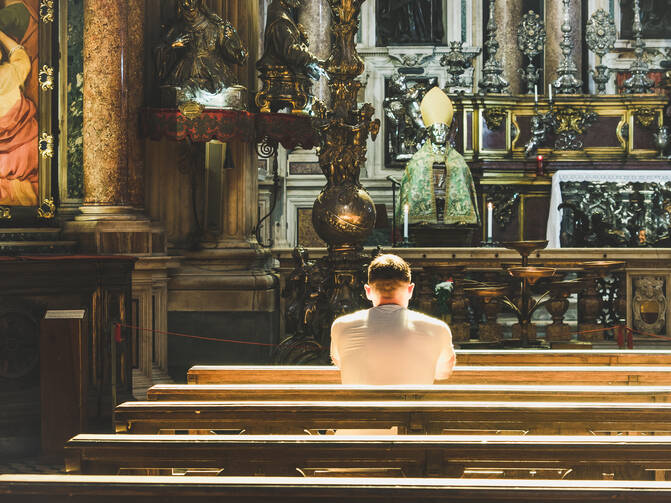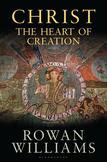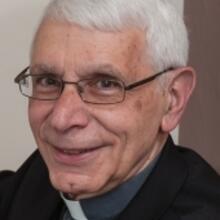Christian belief requires transformation, not facile compromise.
Shortly before Christmas this past year, I came upon a column by the well-known Washington Post and Commonweal commentator E. J. Dionne. In it Dionne penned a sensitive appeal to fellow churchgoers to “cut the ‘Chreasters’ some slack.”
He was referring to those who attend church only occasionally, in particular on Christmas and Easter. After an exhortation to “loyalists” not to be disdainful of “Chreasters” for, “in a sense, free riding,” Dionne went on to offer some more substantive considerations.
He suggested that, though some may be motivated by nostalgia for Christmases past, the presence of large numbers at Christmas and Easter Masses may manifest an “enduring hunger for the experience of the sacred.” Developing the thought further, Dionne drew on the work of the late, great sociologist of religion Peter Berger. In his book A Rumor of Angels, Berger spoke of “signals of transcendence” even in the midst of a secular age, signs of more than a one-dimensional reality.
In his most suggestive formulation, Dionne wondered whether the “Chreasters,” reacting against “a society defined solely by self-interest and calculation, by the visible, the measurable, and the tangible,” might “have an intimation that the world is made up, in the words of the Nicene Creed, of both the ‘seen and unseen’.”
Though I found Dionne’s insights perceptive, I could not help thinking that he had left the “Chreasters” only at the threshold of the mystery that Christmas and Easter celebrate. Even his welcome invocation of the Nicene Creed made no mention of the creator of all that is “seen and unseen.” Much less did the column address the heart of the matter that the Creed professes: “the one Lord Jesus Christ,” consubstantial with the Father, incarnate in time by the Holy Spirit, of the Virgin Mary. Much more than a rumor of angels, the Gospel and the Creed joyfully proclaim “Immanuel,” God with us. Rather than a vague and amorphous transcendence, the feasts revel in a revelation that is “Christomorphic”: formed and founded in Jesus Christ.
In Christ: the Heart of Creation, Rowan Williams undertakes a careful exercise in Christological “grammar,” getting clear about the rules for the appropriate use of language about Christ.
A Singular Claim
My concern at what was missing in the column came into sharper focus through the book I had been reading during the Advent season: Rowan Williams’s Christ: the Heart of Creation. Williams, the Anglican former Archbishop of Canterbury, is one of the premier contemporary Christian theologians in the world today, and I consider this book one of the most significant theological works to appear in recent years.
Williams writes with splendid clarity and exemplary intellectual generosity. But it is the significance of his subject and the depth of his analysis and discussion that make the book especially timely and essential. For Christian faith stands or falls upon the scandalous proclamation of the Incarnation of God’s eternal Word in the mortal humanity of Jesus of Nazareth.
This claim, founded in the New Testament, was substantively elucidated in the great early councils of the church, especially Nicaea and Chalcedon. But the Christian theological tradition through the ages continues to explore the meaning and implications of so singular a claim, to ponder the inexhaustible mystery to which it gives voice. Williams traces the spiritual and intellectual pondering of the mystery in such crucial figures as Aquinas and Scotus, Luther and Calvin, Barth and Bonhoeffer. And, significantly, he gives careful and merited attention to the 20th-century Jesuit philosopher and theologian (whose importance is being newly rediscovered) Erich Przywara.
In Christ: the Heart of Creation, Williams undertakes a careful exercise in Christological “grammar,” getting clear about the rules for the appropriate use of language about Christ. He admits that such an exercise can seem distant from “vivid hymnody and devotional literature, in their dramatic commitment to Jesus of Nazareth as the center and animating power of Christian existence and prayer.” Yet it remains crucial for Christians as they seek “to give an account of the hope that is in them” (1 Pt 3:15).
“About him as well as to him”
Williams excels in appreciation of the aesthetic dimension of Christian existence and theology. He has written marvelous books of meditation upon Christian iconography, penetrating works of Christian spirituality and careful studies of literary figures like Dostoevsky. His sermons inspire and delight both the heart and mind. His devotional writings always exhibit a clear theological structure, while his theological works foster contemplative practice. Still, he is persuaded that Christian prayer and devotion to Jesus of necessity press upon believers “the question of how we are to speak about as well as to him?”
Do we speak in our homilies and sing in our hymns of one who was but God in human disguise, exempt from the struggles and sufferings to which flesh is heir—the hoary specter of “monophysitism”? Or, conversely, do we chant the praises of the superstar who graduated with a degree in divinity—the easy option of “adoptionism?”
Orthodox faith in Christ, and its “grammar” that was refined in the fire of prayer and commitment over centuries, is no facile compromise between these cheap alternatives, but the revolutionary breakthrough into a new understanding of both God and humanity. It is a precious inheritance that can by no means be taken for granted but must be re-appropriated ever anew. Williams’s book is just such an intellectual and spiritual re-appropriation that issues a challenge to us to come and do likewise.
Absent robust belief in the Incarnation (our sole access to God’s Triune reality), Christianity inevitably evaporates into unitarianism and ethical culture.
The implications of the Incarnation
The often technical language employed by the church’s Christological tradition serves to articulate life-transforming realities, new relations between God and human beings and among men and women. Here is how Williams recapitulates the dimensions of incarnational faith:
The finite reality of Jesus embodies infinite divine relatedness, and so its own humanly and historically generated relations are more than instances of routine finite relations: they have the effect of extending and deepening human relations with God, so that the “filiation” that characterizes Jesus is in some measure lived out in believers; and, connected with this, they establish between believers an organic interdependence that radically changes our involvement with and responsibility for others, inside and outside the visible community of faith.
Let me unfold some of what his densely luminous language implies.
First, of course, it recognizes that the infinite God and finite creatures are “incommensurable.” God is mystery: light in whom there is no darkness, in the words of the First Letter of Saint John. God is “totally other,” not merely the human inflated to superhuman proportions. But the implication of this (as Williams, in consonance with the classical Christological tradition, tirelessly asserts) is that there is no competition between God and humanity—no diminishing of one by the proximity of the other. They are not jostling for the same ontological space.
The awesome mystery of the Incarnation is that this transcendent God has become fully human, like us in all but sin. The wonder of the Christmas hymns affectively move the heart to embrace what the head still struggles to fathom: “God in flesh made manifest.”
But Incarnational faith also confesses that at the heart of the mystery is “filiation,” both in eternity and in time. “Of the Father’s Love begotten, ere the world began to be,” intones the ancient hymn; “he is Alpha and Omega, he the source, the ending he.” Incarnational faith opens upon the mystery of the Trinity—not some impersonal transcendent but the tri-personalGod. Absent robust belief in the Incarnation (our sole access to God’s Triune reality), Christianity inevitably evaporates into unitarianism and ethical culture.
The relational energy and exchange that constitute the very life of the Trinity receive unique human expression in the historical reality of Jesus of Nazareth. As Williams says in the passage above: “The finite reality of Jesus embodies infinite divine relatedness.” This is the ineradicable newness of the Christian confession, scandalous enough in itself, yet attaining the utmost depths of scandal in that this infinite divine relatedness receives supreme expression in the crucified Messiah.
Rowan Williams: “To yield to Christ and to recognize that he is the one in whom finite reality is supremely itself requires us to die to our self-constructed identities and to be ready to be identified anew with Christ."
In another passage Williams attests, with almost lyric intensity:
The proper proclamation of the Lordship of the Crucified is more than a rhetorical shock; it is an affirmation of the transforming coincidence of finite and infinite in the detail of this finite life, including and especially its humiliation and powerlessness, in an ultimate “realism” which insists that the unprotected historical fleshliness of the incarnate Word is the appropriate embodiment of the selflessness of the divine.
Thus, if the Triune God’s first gift is creation itself, the second, far surpassing the first, is the fully personal gift of the eternal Word made mortal flesh, even unto death and new life.
A second implication of faith in God incarnate, then, is that God’s gift of divine “filiation,” fully actual in Jesus, becomes, through Jesus, the supernatural calling and dignity of the believer. As the prologue of John’s Gospel proclaims: “To as many as received him, he gave power to become children of God.” Williams writes: “The central themes of classical Christology are closely bound up with the doctrine of Christ’s Headship; that is, to acknowledge the divine life of the Word at work in Jesus is the foundation for thinking of the community of believers as bound together with him in a relation that is unlike any other.”
The Incarnation of the Word in Jesus Christ transforms the finite ego’s buffered defensiveness, its isolating and alienating stratagems. Jesus of Nazareth becomes, especially through his paschal mystery, the source and embodiment of new transformative relations. Thus he cannot be contained within the bounds of individual and independent existence. Rather, he reveals the full reality of personhood, constituted by his defining relations with his Father and those called to become members of his Body, persons in him. Williams writes: “The Word lives in and through those affiliated with Jesus, and, as a result, their lives are also linked to one another in a way that is not simply that of individual to individual, but in a comprehensive pattern of interdependence—the common life of the Body as Paul describes it.”
The Incarnation of the Word continues through Jesus in believers who, in the Johannine image, are branches of the life-bearing vine. Williams comments: “this divine act seeks to extend itself as human agents are incorporated into Christ, and Christ’s solidarity with the whole world is formed in them.”
A third dimension of incarnational faith emits the conviction that the flesh-taking of the eternal Word cannot be limited to the concrete reality of the church but must overflow into concern for and commitment to the true life of the world. Here Williams draws gratefully upon the thought and witness of Dietrich Bonhoeffer, the pastor and theologian executed by the Nazis in the closing days of World War II.
What makes Bonhoeffer so exemplary for Williams is the explicit Christological foundation that he lays for moral discernment and responsibility. Rather than an easy reduction of Jesus to the role of moral teacher or to the object of sentimental piety, Bonhoeffer’s theology is radically Christ-centered. In Christ the very form of humanity is re-created, and all human relations are reoriented toward the reality of Christ. “Thus, where the interdependence of human life shows the radical quality of Christ’s responsibility and representation, where familial, political, or cultural action realizes a more and more unqualified degree of being-for-the-other, it becomes a manifestation of Christ’s underlying and ongoing agency” (my emphasis). As both Bonhoeffer and Williams insist: “The Christological transformation of humanity is the transformation of all our constitutive relationships.” Who but the very Word incarnate would dare exclaim: “The one who loves father or mother more than me is not worthy of me…. the one who does not take up his or her cross and follow me is not worthy of me” (Mt 10:37-38)?
Both have taken the words of the Word to heart, and they lay bare, in uncompromising fashion, “the cost of discipleship.” “To yield to Christ and to recognize that he is the one in whom finite reality is supremely itself requires us to die to our self-constructed identities and to be ready to be identified anew with Christ,” Williams writes. Far from being a philosophical program, much less an ideological cause, incarnational faith is the realization, the making real, of what life in Christ consists in. For “the other person whom I encounter is already the one with whom Christ is in solidarity, and the death I must endure is the death of anything that stops me acknowledging that and acting accordingly.” Christ ever remains the measure, not that which is to be measured.
Thus the “grammar” that governs the language of classical Christology, which Williams explores with such depth and sensitivity, exhibits a distinctive “logic”: the logic of “novum and transformation.” The utter newness of Jesus Christ requires not a merely notional acknowledgement, but a real and ongoing transformation in its recipients.
Christians hear and are witness not to a dim rumor of angels, but to the clarion call of the good news of God’s presence in our midst in the person of Jesus the Christ.
Clarion call
In many ways the more than 260 pages of Williams’s closely reasoned and passionate book are but sustained commentary upon six verses of the New Testament. The stupendous Christological hymn of the letter to the Colossians celebrates Jesus Christ “who is the Image of the invisible God, in whom all things were created, visible and invisible—in him all things hold together. Indeed, he is the Head of the body, the Church, for in him all the fullness of God was pleased to dwell, and through him to reconcile all things to himself, making peace by the blood of the cross” (Col 1:15–20).
Almost 2,000 years of Christian devotion and reflection have barely begun to fathom the depths of this confession. But it is imperative that Christians continue to appropriate and articulate the inexhaustible mystery. For they hear and are witness not to a dim rumor of angels, but to the clarion call of the good news of God’s presence in our midst in the person of Jesus the Christ. What makes that appropriation so challenging, so ex-cruciating, is that it is never accomplished save by passing through the narrow way that is Christ’s cross.
I close, then, with Williams’s summary of incarnational faith:
This divine act [of Incarnation] is recognizable not because it “resembles” any divinity of our imagination, but because it creates a new people in a renewed world. It shows itself divine by utterly refusing what we might be tempted to regard as signs of divinity; by enacting itself ultimately in the emptying of power, the humiliation and the immobilization of the cross. And the resurrection is not a triumphant instance and epiphany of divine power so much as the bare fact of the impossibility of defeating and extinguishing the divine presence in Jesus: As the incarnate and crucified, he lives.
This article also appeared in print, under the headline “The heart of the matter,” in the April 1, 2019, issue.











